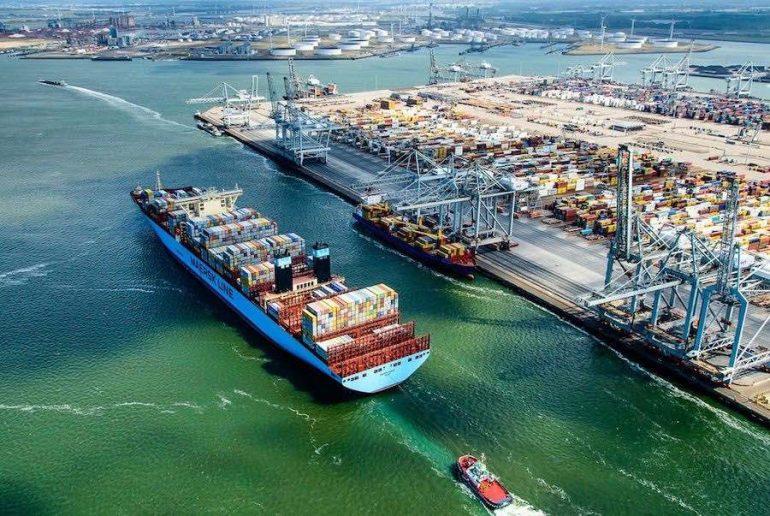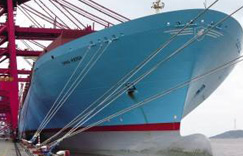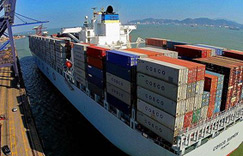The ranking of the world’s top 20 cargo throughput ports was released, with Chinese ports occupying 15 seats
2021-03-18 18:03

A few days ago, the world's top 20 port cargo throughput lists were released. According to the list, the overall production situation of China's ports performed well, occupying 15 seats.
Among them, Ningbo Zhoushan Port has once again become the world's busiest port, with a cargo throughput of more than 1.17 billion tons in 2020, ranking first in the world for twelve consecutive years. Last year, the annual container throughput of Ningbo Zhoushan Port exceeded 28.7 million TEU, ranking third in the world. Official statistics show that the cargo and container throughput of Ningbo Zhoushan Port both increased by more than 4% year-on-year. The port's annual sea-rail intermodal container loading and unloading volume also achieved strong growth, breaking through 1 million TEUs for the first time in 2020, an increase of 24.2% over the previous year. Ningbo Zhoushan Port currently has 19 railway routes connecting 15 provincial cities across the country. Despite the new crown, Ningbo Zhoushan Port's sea-rail combined transport volume in the first half of 2020 and the second half of 2020 increased by more than 15% and 30% year-on-year, respectively, contributing to the restoration of enterprises and the restoration of logistics and industrial chains.
Although Shanghai Port still ranks second, its throughput has stagnated for two consecutive years, while Tangshan Port has maintained rapid growth in both bulk bulk and container throughput, and has the momentum to surpass Shanghai Port. The three ports of Qingdao, Rizhao, and Yantai, which belong to Shandong Port Group, have integrated resources and exerted synergistic effects and achieved steady growth. Tianjin Port promoted the construction of a first-class port, and its throughput increased slightly. The Beibu Gulf Port is the only new face on the list. It has benefited from the new western land-sea channel strategy and its throughput has maintained rapid growth. It has entered the top 20 list and ranked 19th, squeezing out the original Hong Kong port on the list. . The throughput of Hong Kong Port has also been surpassed by Guangzhou and Shenzhen.
Most of the international ports on the list showed varying degrees of decline due to the epidemic, and only Port Hedland had a positive increase in cargo throughput. Among them, the port throughput of Singapore decreased due to the decrease in oil cargo volume. It was surpassed by the ports of Guangzhou and Qingdao, which maintained steady growth, and fell to the sixth place. The weak consumption and production stagnation caused by the epidemic in South Korea have led to a decrease in the throughput of various cargoes. The throughput of Busan Port and Gwangyang Port both dropped by more than 10%. In the Port of Rotterdam, due to the epidemic, the import of raw materials such as iron ore, coal and crude oil has decreased significantly, and the port throughput has also decreased. Port Hedland benefited from the strong growth in the trade volume of China-Australia iron ore, and its cargo throughput increased by 4%.
The increase in the scale of port production is largely due to the trade competitiveness of the country to which it belongs. Port and shipping business is an important means to promote international trade activities. With the advancement of science and technology and the advancement of logistics standardization, most of the international trade of finished products and more and more commodities are transported through container transportation services, which are mainly provided by liner shipping companies. They formed a network that interconnected almost all coastal countries in the world. The liner shipping business now increasingly involves the transshipment of the seaport as a network node. In particular, since 2004, the United Nations Conference on Trade and Development (UNCTAD) has released the Liner Transportation Connectivity Index (LSCI) at the national level every year. The term "connectivity" is increasingly used to characterize national trade competitiveness.
China excels in this respect. In 2020, five of the top ten ports are located in China (Shanghai, Ningbo, Zhoushan, Hong Kong, Qingdao and Xiamen), three are located in other Asian countries (Malaysia, South Korea and Singapore), and the other two are located in Europe (Belgium and the Netherlands) ). Since 2006, the liner shipping connectivity index of almost all the top ten ports has increased significantly, with the exception of Hong Kong, China.
The performance of a seaport is an important determinant of trade costs and connectivity. The longer the ship stays in the port, the less time they have to transport goods at sea for international trade. Longer berthing and loading and unloading times at ports will result in faster navigation at sea, resulting in increased fuel consumption and carbon dioxide emissions, or the need to use other ships to maintain the same service frequency. This also leads to longer transportation times and higher inventory holding costs. These results are not good for the carrier or the shipper. For ports, faster turnaround times are also very important, because they can effectively increase the throughput per meter of shoreline. Therefore, port efficiency and rapid turnover are mutually beneficial.
Shorter port call time is a positive indicator of port efficiency and trade competitiveness, and Chinese ports have also performed well. In 2019, the average port call time of 25 economies around the world was 21.7 hours (0.91 days), slightly lower than the global average. Among the 25 leading countries in terms of container ship port calls, the UAE maintained the shortest port arrival time (weighted port time of 14.1 hours), followed by China (15.5 hours), Singapore (17.4 hours) and South Korea (17.8 hours). This can also reflect from the side that the efficiency of Chinese ports is already at the forefront of the world.
The author found that nowadays, ports are showing more interest in strengthening the connection with the hinterland, to get closer to the cargo owners and tap the volume of cargo that may be carried. The activity of Chinese ports also reflects the prosperity of the hinterland economy to a large extent. Providing multimodal transport, warehousing and other logistics services is also helping ports occupy the market. For example, in South Korea, the Port of Busan is investing in a port distribution center ("distribution park") to strengthen its position as a regional logistics center. In Egypt, the port of Damietta is increasingly focusing on its portal market instead of transshipment business. The development of China's Tianjin Dry Port, Zhejiang Yiwu Dry Port, Xi'an Dry Port, and sea-rail combined transport projects across the country can also illustrate this point. The interaction between Chinese ports is also very active. The port pair that is most closely connected through direct services is China's Ningbo-Shanghai. There are 52 liner shipping companies providing 154 direct services, and the total annual deployment capacity between the two ports is 50.1 million. Standard box. It is followed by Malaysia-Singapore Port Klang with 41 companies; Busan, South Korea-Shanghai, China, with 38 companies; Shanghai and Qingdao, with 37 companies. It is worth noting that the cargo throughput of Qingdao Port has surpassed Busan Port. The top 50 most closely connected port pairs are almost exclusively in Asia, except for Antwerp, Belgium, and Rotterdam, Netherlands, with 24 companies; Hamburg, Germany, and Rotterdam, Netherlands, with 23 companies.
The author believes that this change in strategy and the development of new projects reflects the uncertainty of the port's growth prospects, the diversification of business strategies and the need to cope with the ever-changing situation.
As we all know, in international shipping, the unit value of cargo carried by containers is generally higher than that of bulk cargo. Compared with the ranking of container throughput ports in 2020, Chinese ports have more faces in the cargo throughput list, which means that China's demand for bulk cargo is still high. Thanks to strong intervention in the prevention and control of the epidemic, China has become the most stable exporter of products in the era of the new crown epidemic in the world. China's strong export of finished products to all parts of the world will inevitably lead to a large amount of imports of semi-finished products and raw materials while increasing the throughput of containers. This is also one of the reasons for the excellent performance of Chinese ports in cargo throughput.
With the eastward shift of the global shipping network's center of gravity, Chinese ports have almost "dominantly" on the cargo throughput list. It is gratifying. From the perspective of throughput, China has become a major port country. Such performance is encouraging. But behind the rapid increase in throughput, we still need to stay awake. At present, China's ports are entering a critical period of transition from scale and speed to quality and efficiency. In the past, the port evaluation index system with terminal capacity and throughput as the core has been difficult to meet the needs of high-quality development of ports. In the context of a strong transportation country and exploring the construction of a free trade port, Chinese ports need to rely on free trade pilot zones, free trade port supervision and policy innovation pilots to enhance the international collection of international cargo transfers, entrepot trade, international distribution, international procurement and Supply and other service functions. At the same time, innovate the port management system and mechanism, optimize the port business environment, and realize the transformation of China's ports from large to strong.
Among them, Ningbo Zhoushan Port has once again become the world's busiest port, with a cargo throughput of more than 1.17 billion tons in 2020, ranking first in the world for twelve consecutive years. Last year, the annual container throughput of Ningbo Zhoushan Port exceeded 28.7 million TEU, ranking third in the world. Official statistics show that the cargo and container throughput of Ningbo Zhoushan Port both increased by more than 4% year-on-year. The port's annual sea-rail intermodal container loading and unloading volume also achieved strong growth, breaking through 1 million TEUs for the first time in 2020, an increase of 24.2% over the previous year. Ningbo Zhoushan Port currently has 19 railway routes connecting 15 provincial cities across the country. Despite the new crown, Ningbo Zhoushan Port's sea-rail combined transport volume in the first half of 2020 and the second half of 2020 increased by more than 15% and 30% year-on-year, respectively, contributing to the restoration of enterprises and the restoration of logistics and industrial chains.
Although Shanghai Port still ranks second, its throughput has stagnated for two consecutive years, while Tangshan Port has maintained rapid growth in both bulk bulk and container throughput, and has the momentum to surpass Shanghai Port. The three ports of Qingdao, Rizhao, and Yantai, which belong to Shandong Port Group, have integrated resources and exerted synergistic effects and achieved steady growth. Tianjin Port promoted the construction of a first-class port, and its throughput increased slightly. The Beibu Gulf Port is the only new face on the list. It has benefited from the new western land-sea channel strategy and its throughput has maintained rapid growth. It has entered the top 20 list and ranked 19th, squeezing out the original Hong Kong port on the list. . The throughput of Hong Kong Port has also been surpassed by Guangzhou and Shenzhen.
Most of the international ports on the list showed varying degrees of decline due to the epidemic, and only Port Hedland had a positive increase in cargo throughput. Among them, the port throughput of Singapore decreased due to the decrease in oil cargo volume. It was surpassed by the ports of Guangzhou and Qingdao, which maintained steady growth, and fell to the sixth place. The weak consumption and production stagnation caused by the epidemic in South Korea have led to a decrease in the throughput of various cargoes. The throughput of Busan Port and Gwangyang Port both dropped by more than 10%. In the Port of Rotterdam, due to the epidemic, the import of raw materials such as iron ore, coal and crude oil has decreased significantly, and the port throughput has also decreased. Port Hedland benefited from the strong growth in the trade volume of China-Australia iron ore, and its cargo throughput increased by 4%.
The increase in the scale of port production is largely due to the trade competitiveness of the country to which it belongs. Port and shipping business is an important means to promote international trade activities. With the advancement of science and technology and the advancement of logistics standardization, most of the international trade of finished products and more and more commodities are transported through container transportation services, which are mainly provided by liner shipping companies. They formed a network that interconnected almost all coastal countries in the world. The liner shipping business now increasingly involves the transshipment of the seaport as a network node. In particular, since 2004, the United Nations Conference on Trade and Development (UNCTAD) has released the Liner Transportation Connectivity Index (LSCI) at the national level every year. The term "connectivity" is increasingly used to characterize national trade competitiveness.
China excels in this respect. In 2020, five of the top ten ports are located in China (Shanghai, Ningbo, Zhoushan, Hong Kong, Qingdao and Xiamen), three are located in other Asian countries (Malaysia, South Korea and Singapore), and the other two are located in Europe (Belgium and the Netherlands) ). Since 2006, the liner shipping connectivity index of almost all the top ten ports has increased significantly, with the exception of Hong Kong, China.
The performance of a seaport is an important determinant of trade costs and connectivity. The longer the ship stays in the port, the less time they have to transport goods at sea for international trade. Longer berthing and loading and unloading times at ports will result in faster navigation at sea, resulting in increased fuel consumption and carbon dioxide emissions, or the need to use other ships to maintain the same service frequency. This also leads to longer transportation times and higher inventory holding costs. These results are not good for the carrier or the shipper. For ports, faster turnaround times are also very important, because they can effectively increase the throughput per meter of shoreline. Therefore, port efficiency and rapid turnover are mutually beneficial.
Shorter port call time is a positive indicator of port efficiency and trade competitiveness, and Chinese ports have also performed well. In 2019, the average port call time of 25 economies around the world was 21.7 hours (0.91 days), slightly lower than the global average. Among the 25 leading countries in terms of container ship port calls, the UAE maintained the shortest port arrival time (weighted port time of 14.1 hours), followed by China (15.5 hours), Singapore (17.4 hours) and South Korea (17.8 hours). This can also reflect from the side that the efficiency of Chinese ports is already at the forefront of the world.
The author found that nowadays, ports are showing more interest in strengthening the connection with the hinterland, to get closer to the cargo owners and tap the volume of cargo that may be carried. The activity of Chinese ports also reflects the prosperity of the hinterland economy to a large extent. Providing multimodal transport, warehousing and other logistics services is also helping ports occupy the market. For example, in South Korea, the Port of Busan is investing in a port distribution center ("distribution park") to strengthen its position as a regional logistics center. In Egypt, the port of Damietta is increasingly focusing on its portal market instead of transshipment business. The development of China's Tianjin Dry Port, Zhejiang Yiwu Dry Port, Xi'an Dry Port, and sea-rail combined transport projects across the country can also illustrate this point. The interaction between Chinese ports is also very active. The port pair that is most closely connected through direct services is China's Ningbo-Shanghai. There are 52 liner shipping companies providing 154 direct services, and the total annual deployment capacity between the two ports is 50.1 million. Standard box. It is followed by Malaysia-Singapore Port Klang with 41 companies; Busan, South Korea-Shanghai, China, with 38 companies; Shanghai and Qingdao, with 37 companies. It is worth noting that the cargo throughput of Qingdao Port has surpassed Busan Port. The top 50 most closely connected port pairs are almost exclusively in Asia, except for Antwerp, Belgium, and Rotterdam, Netherlands, with 24 companies; Hamburg, Germany, and Rotterdam, Netherlands, with 23 companies.
The author believes that this change in strategy and the development of new projects reflects the uncertainty of the port's growth prospects, the diversification of business strategies and the need to cope with the ever-changing situation.
As we all know, in international shipping, the unit value of cargo carried by containers is generally higher than that of bulk cargo. Compared with the ranking of container throughput ports in 2020, Chinese ports have more faces in the cargo throughput list, which means that China's demand for bulk cargo is still high. Thanks to strong intervention in the prevention and control of the epidemic, China has become the most stable exporter of products in the era of the new crown epidemic in the world. China's strong export of finished products to all parts of the world will inevitably lead to a large amount of imports of semi-finished products and raw materials while increasing the throughput of containers. This is also one of the reasons for the excellent performance of Chinese ports in cargo throughput.
With the eastward shift of the global shipping network's center of gravity, Chinese ports have almost "dominantly" on the cargo throughput list. It is gratifying. From the perspective of throughput, China has become a major port country. Such performance is encouraging. But behind the rapid increase in throughput, we still need to stay awake. At present, China's ports are entering a critical period of transition from scale and speed to quality and efficiency. In the past, the port evaluation index system with terminal capacity and throughput as the core has been difficult to meet the needs of high-quality development of ports. In the context of a strong transportation country and exploring the construction of a free trade port, Chinese ports need to rely on free trade pilot zones, free trade port supervision and policy innovation pilots to enhance the international collection of international cargo transfers, entrepot trade, international distribution, international procurement and Supply and other service functions. At the same time, innovate the port management system and mechanism, optimize the port business environment, and realize the transformation of China's ports from large to strong.







